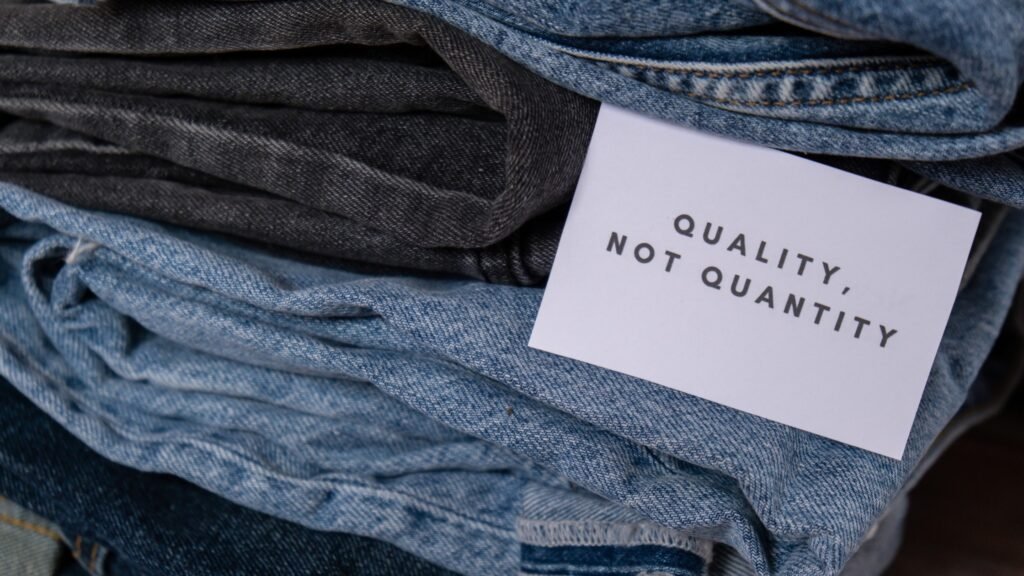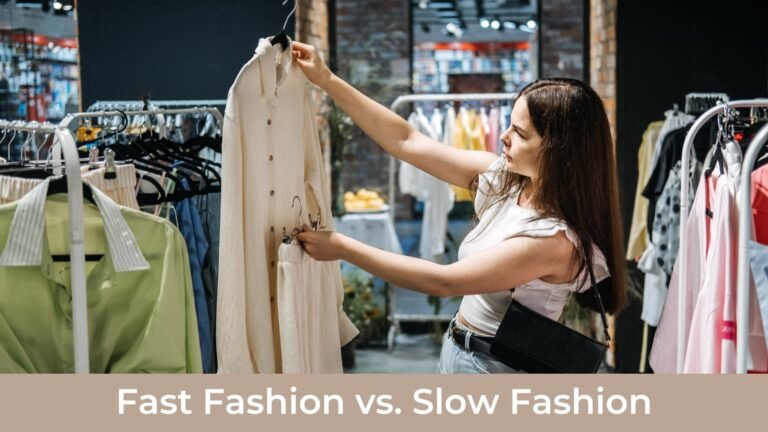In today’s highly competitive apparel industry, where consumer expectations are rising and global supply chains are under constant pressure, the debate between fast and slow fashion has become more important.
With sustainability becoming a central concern for consumers and businesses alike, the question arises: which model is more sustainable for the future?
The apparel industry is one of the largest contributors to environmental damage, and both fast fashion and slow fashion models have their impact on the planet.
In this blog, we will dive into the differences between fast and slow fashion, analyze their sustainability aspects, and explore why sustainable fashion is the key to a more ethical and eco-friendly future.
We’ll also take a closer look at Kanika Global, a company that’s leading the way sustainably, proving that high-quality production can coexist with environmental responsibility.
1. What is Fast Fashion?

Fast fashion refers to the mass production of inexpensive clothing, designed to quickly meet the latest trends in the fashion world.
The focus of fast fashion is on speed and affordability, with brands constantly updating their collections to stay in line with current trends.
This model relies heavily on low-quality fabrics, cheap labor, and quick production cycles to keep costs down.
While fast fashion offers a quick solution to meeting consumer demand for trendy clothing at a low price, the environmental and social costs are high:
- Environmental Damage: The fast fashion industry contributes to massive textile waste. With millions of garments ending up in landfills each year, the carbon footprint of these products is enormous.
Additionally, the use of synthetic fabrics, like polyester, exacerbates the environmental damage as these materials do not decompose easily. - Wasteful Consumption: The fast fashion model promotes disposable consumption, where cheap clothing is bought and discarded after a few wears, encouraging overproduction and overconsumption.
- Unethical Labor Practices: To keep prices low, many fast fashion brands rely on factories in developing countries where workers are paid meager wages and subjected to unsafe working conditions.
In contrast, Kanika Global offers a sustainable fashion solution by prioritizing ethical manufacturing practices.
By adopting eco-friendly materials, such as organic cotton and recycled fibers, and using energy-efficient production processes, Kanika Global demonstrates that high-quality fashion can be both ethical and sustainable.
2. What is Slow Fashion?

Slow fashion is an alternative to fast fashion that focuses on quality, longevity, and sustainability.
Slow fashion aims to produce fewer garments but ensures that each piece is well-made, using high-quality materials that last longer.
Rather than focusing on keeping up with rapidly changing trends, slow fashion emphasizes creating timeless pieces that are designed to be worn for years.
The slow fashion movement promotes the following principles:
- Sustainability: Slow fashion emphasizes using eco-friendly materials, reducing waste, and adopting more sustainable production methods.
- Ethical Production: Slow fashion advocates for fair labor practices, ensuring that workers are paid fairly and work in safe conditions.
- Longevity Over Disposability: Slow fashion encourages consumers to invest in high-quality garments that will last longer and stand the test of time, reducing the need for constant buying.
Kanika Global is a prime example of a company that has embraced the principles of slow fashion.
By using organic fabrics, eco-friendly dyes, and energy-efficient machinery, Kanika Global ensures that each garment is produced in an environmentally responsible manner.
Their commitment to sustainability goes beyond just fabric; it’s about creating a sustainable fashion ecosystem that values long-term impact over quick profits.
3. Sustainability in Fast Fashion vs. Slow Fashion

When it comes to sustainability, the contrast between fast fashion and slow fashion couldn’t be starker. Let’s break down how each model affects the environment and society:
Environmental Impact:
- Fast Fashion: The fast fashion model contributes massively to environmental degradation.
The constant cycle of producing cheap clothing leads to significant carbon emissions, overuse of water resources, and waste accumulation.
The industry is also known for using synthetic fabrics, which release microplastics into the environment. - Slow Fashion: Slow fashion, on the other hand, promotes sustainability by encouraging the use of natural materials, organic fabrics, and water-efficient dyeing techniques.
By producing fewer garments, the slow fashion model significantly reduces waste, promoting a circular fashion system where garments are either recycled, repurposed, or reused.
Kanika Global is committed to sustainable practices that align with the slow fashion model.
With initiatives like energy-efficient machinery, zero-waste production techniques, and the use of organic materials, Kanika Global is making strides in reducing the environmental footprint of its garment manufacturing processes.
Social Responsibility:
- Fast Fashion: Fast fashion is frequently criticized for exploiting cheap labor in countries with less stringent labor laws. Factory workers often work long hours in poor conditions for very low pay.
- Slow Fashion: The slow fashion movement ensures that workers receive fair wages and work in safe, healthy environments. Brands that embrace slow fashion often partner with factories that uphold ethical labor practices.
Kanika Global is a prime example of a company that integrates both environmental and social responsibility into its sustainable fashion production model.
By ensuring fair wages and working conditions in their factories, Kanika Global creates a sustainable fashion ecosystem that respects both people and the planet.
4. The Role of Kanika Global in Promoting Sustainable Fashion

As the demand for sustainable fashion increases, Kanika Global is a key player in leading the change towards ethical production.
By adopting the principles of slow fashion, Kanika Global has demonstrated that it is possible to produce high-quality garments while maintaining a commitment to sustainability.
Here’s how Kanika Global is promoting sustainable fashion:
- Eco-Friendly Materials: Kanika Global uses GOTS-certified organic cotton and recycled fabrics in its production process, ensuring that its garments are not only high-quality but also environmentally friendly.
- Energy-Efficient Production: By investing in energy-efficient machinery, Kanika Global reduces its carbon footprint, ensuring that each garment produced has minimal environmental impact.
- Ethical Labor Practices: Kanika Global adheres to ethical labor standards, ensuring that all workers are paid fair wages and work in safe conditions. Their commitment to fair labor practices aligns perfectly with the values of slow fashion.
- Certifications and Standards: Kanika Global holds several sustainability certifications, including ISO 9001, OEKO-TEX, and SEDEX, proving their commitment to producing sustainable fashion that meets the highest global standards.
By adopting these sustainable fashion practices, Kanika Global is proving that high-quality, ethically made garments can coexist with environmental responsibility, setting an example for the entire fashion industry.
5. The Future of Fashion: Fast Fashion or Slow Fashion?

As consumer awareness of environmental and social issues grows, the future of fashion is leaning towards sustainable fashion. While fast fashion remains a dominant force, slow fashion offers a more responsible, ethical approach that is better suited to today’s conscious consumer.
The transition to slow fashion is driven by the growing demand for sustainably produced garments. Consumers are increasingly looking for eco-friendly options that align with their values and reduce their environmental impact.
As this demand grows, more fashion brands will need to adopt sustainable fashion practices to stay relevant. Kanika Global is leading the way by embracing slow fashion principles and sustainable production practices.
Their commitment to producing high-quality garments using eco-friendly materials and ethical labor standards ensures that they are well-positioned for the future of fashion.
Final Thoughts: Embracing Sustainable Fashion for a Greener Future

The debate between fast fashion and slow fashion is ultimately about more than just the speed of production or the cost of garments. It’s about creating a future where fashion is both eco-friendly and ethically produced.
While fast fashion may still be prevalent today, slow fashion offers a more sustainable future for the industry. Brands like Kanika Global are proving that it is possible to produce high-quality garments while maintaining a commitment to sustainability.
By prioritizing ethical labor practices, eco-friendly materials, and energy-efficient production, Kanika Global is setting the standard for what sustainable fashion should look like in the future.
For fashion brands looking to make a positive impact, partnering with Kanika Global is the key to creating a sustainable fashion future.
Embracing slow fashion principles not only benefits the planet but also builds a loyal customer base that values responsibility and quality over quick, disposable trends.
FAQs
Q1: What is the difference between fast fashion and slow fashion?
Fast fashion focuses on producing large quantities of cheap, trendy clothing quickly to meet current fashion demands. It relies on low-cost labor, synthetic materials, and fast production cycles, which often lead to environmental damage and unethical labor practices. In contrast, slow fashion prioritizes quality, durability, and sustainability by using eco-friendly materials and producing fewer garments that are built to last. Kanika Global embraces slow fashion, creating high-quality garments with sustainable materials and ethical practices.
Q2: How does fast fashion contribute to environmental damage?
Fast fashion contributes to environmental damage through overproduction, textile waste, and the use of synthetic fabrics that do not decompose. The mass production of cheap clothing leads to large quantities of garments being discarded in landfills. Kanika Global focuses on reducing environmental impact by using organic cotton, recycled fabrics, and energy-efficient production methods, aligning with slow fashion values to minimize waste and carbon emissions.
Q3: Why is slow fashion considered more sustainable?
Slow fashion is more sustainable because it emphasizes quality over quantity. It promotes the use of eco-friendly materials, ethical labor practices, and production methods that reduce waste. By producing fewer garments designed to last longer, slow fashion minimizes the impact on the environment and encourages responsible consumption. Kanika Global follows these principles by producing durable, high-quality garments that meet the growing demand for sustainable fashion.
Q4: Can slow fashion be affordable?
While slow fashion typically comes with a higher upfront cost due to the use of quality materials and ethical production, it provides long-term value because it encourages consumers to buy less and invest in durable, timeless pieces. Kanika Global ensures that sustainable fashion remains accessible by offering affordable, high-quality garments produced through eco-friendly methods, helping brands provide consumers with responsible fashion choices.


